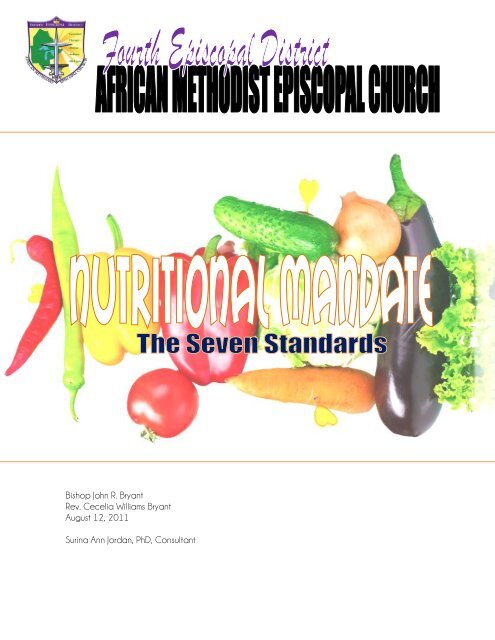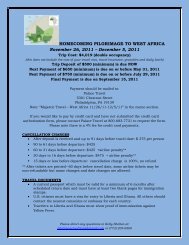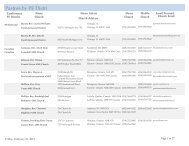Fourth District Nutritional Mandate - Fourth Episcopal District
Fourth District Nutritional Mandate - Fourth Episcopal District
Fourth District Nutritional Mandate - Fourth Episcopal District
Create successful ePaper yourself
Turn your PDF publications into a flip-book with our unique Google optimized e-Paper software.
Bishop John R. Bryant<br />
Rev. Cecelia Williams Bryant<br />
August 12, 2011<br />
Surina Ann Jordan, PhD, Consultant
The following standards are nutritional disciplines and practices for the <strong>Fourth</strong> <strong>Episcopal</strong> <strong>District</strong>. This<br />
recommendation provides the framework and supports the health and well being of the people districtwide.<br />
These are to be implemented by each pastor in the local congregation and to be reportable at<br />
the Presiding Elders’ quarterly conference.<br />
The new wellness culture for the 4 th district provides the framework for prevention and disease<br />
management. In the 4 th district we are concerned about the number of children who are overweight<br />
and the families being impacted by various chronic diseases, including heart disease, stroke, cancer,<br />
diabetes, and arthritis and obesity. These chronic diseases are among the most common, costly, and<br />
preventable of all health problems in the U.S., according to the Center for Disease Control and<br />
Prevention. 1 Seven (7) out of ten (10) deaths related to these ailments are preventable.<br />
Overweight and obesity are associated with heart disease,<br />
certain types of cancer, type 2 diabetes, stroke, arthritis,<br />
breathing problems, and psychological disorders, such as<br />
depression. The leading causes of poor health are lack of<br />
physical activity, poor nutrition, tobacco use, and excessive<br />
alcohol consumption—are responsible for much of the illness,<br />
suffering, and early death related to chronic diseases. We can<br />
prevent many of these diseases by simply eating differently.<br />
The following Seven Standards are based on holistic and<br />
scientific information:<br />
• SEE EATING AS AN ACT OF WORSHIP<br />
• EAT SIMPLY, PLAIN AND PURE<br />
• DRINK PURE<br />
• EAT HEALTHY SNACKS<br />
• PLAN YOUR MEALS<br />
• CONTROL YOUR PORTIONS<br />
• HAVE AT LEAST ONE MEAL A DAY AS A FAMILY<br />
2
Explanation of the Standards<br />
1. SEE EATING AS AN ACT OF WORSHIP<br />
Our bodies are the temple of the Holy Spirit of God. There is a relationship between our walk with Christ<br />
and how we treat our bodies. We must repent of any abuse to our bodies and ask God to renew our taste<br />
and desire for healthy foods. As a living sacrifice, we must render unto God the healthy vessel for his glory<br />
and his purpose for our lives.<br />
2. EAT SIMPLY AND PURE<br />
Eating simply means eating foods that have not been over-processed or eating foods that are closest to the<br />
farm and the garden. Shop the farmer’s markets or the outer walls (example, produce, milk & meat<br />
sections) of the grocery store. The body needs protein, carbohydrates, fats, vitamins, and minerals. Eating<br />
the following foods daily will provide all of these nutrients.<br />
Basic Nutrients for a Healthy Diet<br />
PROTEIN<br />
CARBOHYDRATES<br />
FATS<br />
Best Sources: Beans, peas, vegetables, potatoes, whole grains and fish<br />
OK Sources: Poultry and less red meat, eggs and dairy.<br />
Worse Sources: Fried Chicken, Fried Seafood, pizzas, burgers, whole milk,<br />
butter, cheese and shell fish.<br />
Adequate protein can be obtained without meat.<br />
Best sources: Fresh fruit, fresh vegetables and whole grains<br />
Worse sources: Refined sugar, candy, white flour/pasta and white rice<br />
Best Sources: Olive Oil, Canola, Safflower, Sesame and unheated Flax seed oil<br />
Worse Sources: Saturate fats from meat, margarines, shortenings, and products<br />
using these ingredients<br />
Fruits and vegetables are important for optimal child growth, weight<br />
management, and chronic disease prevention. 2, 3, 4 The Dietary<br />
Guidelines for Americans, day released in January 2005, recommend 2<br />
to 6 1/2 cups of fruits and vegetables a or the equivalent of 4 to 13<br />
servings.<br />
God provided fruit, vegetables and grains as the healing agents to<br />
detoxify, restore and heal our bodies. Genesis 1:29 And God said,<br />
“Behold, I have given you every herb bearing seed, which is upon the<br />
face of all the earth, and every tree, in the which is the fruit of a tree<br />
yielding seed; to you it shall be for meat”.<br />
Recent surveys show that less than 22% of high school students and<br />
only 24% of adults 5 reported eating 5 or more servings of fruits and<br />
vegetables per day. As parents, youth ministry leaders, pastors, we must<br />
model good eating behaviors for our children.<br />
Fresh fruit should be consumed as opposed to processed fruit in sugar sweetened syrup.<br />
Encourage the consumption of whole vegetables or fruit in place of juices. Vegetables can be raw, lightly<br />
steamed, stir fried, roasted or added to soups. Eat fresh, frozen or canned vegetables without high calorie<br />
sauces and added salt,<br />
Meat consumption is still very high and beef consumption remains higher than poultry according to the study<br />
conducted by the National Cancer Institute. Americans consume three times more meat than the global<br />
average, which greatly impacts our ability to prevent chronic disease. 6, 7<br />
3
All meat including poultry should be consumed less. Meat and shellfish are the<br />
major sources of dietary cholesterol. The body naturally produces cholesterol<br />
and is not in need of another source. Therefore, meatless meals at least twice<br />
or more a week is highly recommended. Limit processed meats that are high in<br />
saturated fat and sodium.<br />
Meat should be baked, roasted or gas-grilled; not fried. Use lean cuts of meat<br />
and remove skin from poultry before eating.<br />
Include fish twice a week, preferably oil fish including salmon, mackerel, or<br />
tuna (not shell fish, like shrimp, crab or lobster)<br />
Grains include cereals, brown rice, wholegrain pasta, corn, whole grain<br />
couscous, quinoa and barley<br />
Beans and Peas (legumes)<br />
The 2010 Dietary Guidelines for Americans also recommended consuming fewer calories,<br />
filling half of the plate with fruits and vegetables, reducing sodium, and drinking water instead<br />
of sugary drinks.<br />
Note that three quarters of the healthy plate is plant-based. Your protein can consist of beans, grains,<br />
nuts and seed and seafood, all of which are low fat options. Calcium-fortified soymilk (soy beverage) is<br />
also part of the Dairy Group.<br />
Avoiding Sugar<br />
The Dietary Guidelines for Americans 2005 8 indicates the healthiest way to reduce caloric intake is to<br />
decrease one’s consumption of added sugars, fats, and alcohol, all of which provide calories but few or<br />
no essential nutrients. The names of sugars include:<br />
Brown sugar<br />
Corn sweetener<br />
Corn syrup<br />
Dextrose<br />
Fruit juice concentrates<br />
Glucose<br />
High-fructose corn syrup<br />
Honey<br />
Invert Sugar<br />
Lactose<br />
Maltose<br />
Malt syrup<br />
Molasses<br />
Raw sugar<br />
Sucrose<br />
Sugar<br />
Syrup Corn<br />
The American Heart Association recommends limiting sugar-sweetended beverages to less than 450<br />
calories per week (36 ounces).<br />
4
Salt<br />
Reduce salt intake to 1500 milligrams per day. Here are some suggestions to help.<br />
Choose and prepare foods with little or no salt.<br />
Limit the use of condiments such as soy sause and ketchup<br />
If choosing processed foods, look for those reduced in sodium.<br />
Compare the sodium content of various brands and choose those with less sodium.<br />
3. DRINK PURE<br />
The body is over 80% water. Water must be the first choice beverage in order to maintain good health. The lack<br />
of water affects every part of your body, especially the brain. For a low calorie drink add lemon or a bit of fruit or<br />
vegetable juice. Avoid caffeinate beverages as they pull water out of the body.<br />
Suggested water Intake:<br />
ADULTS<br />
CHILDREN<br />
6 to 8 Glasses per day<br />
Step 1 - Divide your child’s weight by 2 to get<br />
ounces<br />
Step 2 – Divide ounces by 8 to get number of<br />
glasses<br />
Avoiding Sugar-sweeten beverages:<br />
A large proportion of added sugar in the American diet comes from the consumption of sugar-sweetened<br />
beverages. We are drinking our calories. The Dietary Guidelines for Americans 2005 8 indicates that one-way<br />
for people to reduce their intake of added sugars is to reduce the amount of sugar-sweetened beverages they<br />
drink. The consumption of sugar-sweetened beverages begins in early childhood and increases as children<br />
age. In 2002, the Feeding Infants and Toddlers Study (FITS) reported that 44% of toddlers aged 19–24 months<br />
old had consumed either fruit drinks (38%) or carbonated soda (11%) at least once a day 9 .<br />
A study conducted by RP Troiano using National Health and Nutrition Examination Surveys 10, 11 , data found that<br />
overweight youth aged 2–19 years old consumed a higher proportion of their calories from carbonated soft<br />
drinks (regular and low calorie) than their non-overweight counterparts supplemental foods and beverages<br />
containing added sugar compared to another group that received supplemental foods and beverages<br />
sweetened with artificial sweetener.<br />
In 1997, soft drink and bottled water manufacturers spent $702 million on advertising, not including the<br />
additional funds spent on marketing. 12, 13, 14 Much of the promotion focuses on children, because of their increased<br />
spending power, purchasing influence, and future as adult consumers. These facts reinforce our need to limit<br />
the amount of TV being watched by our children.<br />
Coffee<br />
Coffee should not be used to replace water. Coffee removes water from the body.<br />
4. PLAN YOUR MEALS<br />
Before you go to the grocery store of farmer’s market, decide what you would like to have to available for<br />
breakfast each day and make a list of what you will need to purchase.<br />
Next, decide what you and your children will have for lunch each day. Add all the ingredients for lunch to your<br />
list. Next, what will you have for dinner each day? Dinner can be used as leftovers for lunch or breakfast. Write<br />
that down. Once your list is complete, check your pantry to see what you have on the list and adjust.<br />
Buy a little extra fruits and vegetables in season and freeze a portion of it for the winter.<br />
5
5. EAT HEALTHY SNACKS<br />
Healthy snacks between meals prevent over eating at mealtime. The<br />
following are some snack ideas. If a meal is skipped use a healthy snack<br />
to offset the missed meal.<br />
• Fresh fruit – fist-size piece or ½ cup<br />
• Fruit cup or apple sauce or dried fruit<br />
• Juice: 3-4 oz<br />
• 5 Medium Carrots and ½ apple<br />
• Homemade trail mix<br />
• Small box of raisins<br />
• Handful of carob covered raisins or nuts (barley sweetened)<br />
• Smoothies with fruit, milk (or nondairy milk), add tbsp nut butter or yogurt<br />
for more protein)<br />
• Peanut or Soy Nut butter (taste like peanut butter but easier to digest)<br />
bread or crackers or sliced apples, celery or rice cakes<br />
• Peanut or Soy could be replaced with almond butter<br />
• Raw Veggies with Hummus (a chickpea spread) or whole grain pita<br />
• Cashews or Almonds, dry roasted (delicious, high calories – good fat)<br />
• Non-dairy - Frozen desserts with nuts or raisin or berries; from popsicles<br />
to nondairy ice Cream sandwiches, bars and more can be found at the<br />
health food store<br />
• Desserts made with Rice or soy or coconut<br />
• Fig bars, graham crackers (no sugar coated)<br />
• Butter-less Popcorn – Air pop the corn, then spray olive oil cooking<br />
spray, sprinkle with garlic or curry powder and a little sea salt or sea kelp<br />
if needed.<br />
• Cookies from the health food store with milk (almond, soy or rice)<br />
• Low salt, fruit sweetened energy bar from the health food store<br />
6
6. CONTROL YOUR PORTIONS - LESS IS BEST<br />
Serving sizes in restaurants, groceries and vending machines have become larger over the years. The Center<br />
for Disease Control (CDC) provides the following tips to help control portions and reduce overeating: 15<br />
When eating out, split your entrée with a friend or ask for a “to go” box and wrap half of your meal as<br />
soon as it is served.<br />
When eating in, serve the meal on individual plates. Do not place<br />
serving bowls on the table.<br />
Avoid mindless eating. When eating or snacking in front of the TV or<br />
the computer, put the amount that you plan to eat into a bowl or<br />
container instead of eating straight from the package.<br />
If you feel hungry between meals, eat a healthy snack, like a piece of<br />
fruit or small salad, to avoid overeating during your next meal.<br />
Beware of large packages. Divide up the contents of one large package into several smaller containers<br />
to help avoid over-consumption.<br />
Out of sight, out of mind. Replace the candy dish with a fruit bowl.<br />
Store especially tempting foods, like cookies, chips, or ice cream, out of immediate eyesight, like on a<br />
high shelf or at the back of the freezer. Move the healthier food to the front at eye level.<br />
When buying in bulk, store the excess in a place that's not convenient to get to, such as a high cabinet<br />
or at the back of the pantry.<br />
Dr. Surina Ann Jordan, senior health advisor and researcher for Zima Health has also made successful<br />
interventions in portion control by using less processed meals, smaller plates and training on eating slower and<br />
chewing well.<br />
Other Tips:<br />
<br />
<br />
<br />
<br />
Don’t eat late<br />
Have your largest meal before 7 p.m. If you must eat after 7 p.m. have a healthy snack (see healthy<br />
snack list).<br />
Remember, “Less is best”.<br />
Always carry a healthy snack with you<br />
7. HAVE AT LEAST ONE MEAL A DAY AS A FAMILY<br />
Breaking bread together as a household each day ensures that at least one meal meets the standards and that<br />
everyone values the importance of healthy eating. The shared experience, someone chops vegetables, another<br />
sets the table, and someone else washes dishes. A shared meal reinforces the connectedness, emotional and<br />
spiritual well being of each person. Be creative in that it may seem difficult to start. Breakfast smoothie or<br />
building tacos, all will look forward to it overtime. If you study the life of Jesus, much time was spent breaking<br />
bread and sharing around a meal.<br />
7
References:<br />
1. Center for Disease Control and Prevention, Chronic Disease and Health Promotion, Available<br />
from: www.cdc.gov/chronicdisease/overview/index.htm.<br />
2. CDC Nutrition, Physical Activity and Obesity Legislative Database. Date accessed July 1,<br />
2009. Available at http://apps.nccd.cdc.gov/DNPALeg/.<br />
3. National Conference of State Legislatures Healthy Community Design and Access to Healthy<br />
Food Legislation Database. Date accessed August 11, 2009. Available at<br />
http://www.ncsl.org/?tabid=13227.*<br />
4. Centers for Disease Control and Prevention. Youth risk behavior surveillance—United States,<br />
2007. MMWR 2008;57(SS-04):1–131. Available from:<br />
http://www.cdc.gov/mmwr/preview/mmwrhtml/ss5704a1.htm<br />
5. BRFSS prevalence and trends data [Internet]. Atlanta, GA: Centers for Disease Control and<br />
Prevention; 2008. Available from:<br />
http://apps.nccd.cdc.gov/brfss/page.asp?cat=AC&yr=2007&state=US#AC<br />
6. <strong>Nutritional</strong> Epidemiology Branch, Division of Cancer Epidemiology and Genetics, National<br />
Cancer Institute, National Institutes of Health, Department of Health and Human Services,<br />
Bethesda, MD, U.S.A.<br />
7. Department of Research and Evaluation, Kaiser Permanente Southern California, Pasadena,<br />
CA, U.S.A. Available at: http://www.ncbi.nlm.nih.gov/pmc/articles/PMC3045642/<br />
8. U.S. Department of Health and Human Services and U.S. Department of Agriculture. Dietary<br />
Guidelines for Americans 2005. Washington, DC: U.S. Government Printing Office; 2005.<br />
9. Fox MK, Pac S, Devaney B, Jankowski L. Feeding Infants and Toddlers Study: what foods are<br />
infants and toddlers eating? Journal of the American Dietetic Association 2004;104(Suppl 1):22-<br />
30.<br />
10. Troiano RP, Briefel RR, Carroll MD, Bialostosky K. Energy and fat intakes of children and<br />
adolescents in the United States: data from the National Health and Nutrition Examination<br />
Surveys. American Journal of Clinical Nutrition 2000;72(5):1343S-1353S.<br />
11. Welsh J, Cogswell M, Rogers S, Rockett H, Mei Z, Grummer-Strawn L. Overweight among<br />
low-income preschool children associated with the consumption of sweet drinks:<br />
12. Story M, French S. Food advertising and marketing directed at children and adolescents in<br />
the US. International Journal of Behavioral Nutrition and Physical Activity 2004;1(1):3.<br />
13. Gallo, AE. Food advertising in the United States. In: Frazao E, editor. America’s Eating<br />
Habits: Changes and Consequences. Agriculture Information Bulletin Number 750. Washington,<br />
DC: U.S. Department of Agriculture; 1999.<br />
14. Dalmeny, K, Hanna, E, and Lobstein, T. Broadcasting bad health: why food marketing to<br />
children needs to be controlled. London: The International Association of Consumer Food<br />
Organizations; 2003.<br />
15. Center for Disease Control and Prevention, How to Avoid Portion Size Pitfalls to Help Manage<br />
Your Weight. Available from: www.cdc.gov/healthyweight/healthy_eating/portion_size.html.<br />
8
















